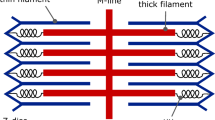Abstract
A realistic model for two synchronized motor unit action potential trains (MUAPT) is presented in which the variability of the time difference between corresponding action potentials (hereafter denoted by delay) is taken into account. Specifically, this delay is modeled as a continuous random variable that may assume both positive and negative values.
Expressions are derived for the auto- and cross-power spectra of two such trains using their relations with the auto- and cross-correlation functions, respectively, with which they form Fourier transform pairs.
The results show that the auto- and the cross-power spectra of two such synchronized MUAPTs differ from the auto- and the cross-spectra of two independent MUAPTs. The contribution of the statistics of the interpulse intervals to one of the autopower spectra is smaller and the cross-power spectra no longer reduce to a Dirac δ-function at the origin but are now determined by the other auto-power spectrum and by the Fourier transform of the density function associated with the time difference between corresponding action potentials. As a consequence of this change in the cross-power spectra synchronization leads to an absolute increase of power at low frequencies and to a relative decrease of power at high frequencies.
The results are then generalized to electromyograms (EMG) composed of more than just two MUAPTs and illustrated with simulated power spectra with which the theory shows excellent agreement.
Similar content being viewed by others
References
Agarwal, G.C., Gottlieb, G.L.: An analysis of the electromyogram by Fourier, simulation and experimental techniques. IEEE Trans. BME-22, 225–229 (1975)
Bigland-Ritchie, B., Donovan, E.F., Roussos, C.S.: Conduction velocity and EMG power spectrum changes in fatigue of sustained maximal efforts. J. Appl. Physiol.: Respirat. Environ. Exercise Physiol. 51, 1300–1305 (1981)
Birö, G., Partridge, L.D.: Analysis of multiunit spike records. J. Appl. Physiol. 30, 521–526 (1971)
Blinowska, A., Verroust, J., Cannet, G.: The determination of motor units characteristics from the low frequency electromyographic power spectra. Electromyogr. Clin. Neurophysiol. 19, 281–290 (1979)
Blinowska, A., Verroust, J., Cannet, G.: An analysis of synchronisation and double discharge effects on low frequency electromyographic power spectra. Electromyogr. Clin. Neurophysiol. 20, 465–480 (1980)
Buchthal, F., Madsen, A.: Synchronous activity in normal and atrophic muscle. Electroencephalogr. Clin. Neurophysiol. 2, 425–444 (1950)
Christakos, C.N.: A linear stochastic model of the single motor unit. Biol. Cybern. 44, 79–89 (1982)
Christakos, C.N., Lal, S.: Lumped and population stochastic models of skeletal muscle: implications and predictions. Biol. Cybern. 36, 73–85 (1980)
Coggshall, J.C.: Linear models for biological transducers and impulse train spectra: general formulation and review. Kybernetik 13, 30–37 (1973)
Coggshall, J.C., Bekey, G.A.: A stochastic model of skeletal muscle based on motor unit properties. Math. Biosci. 7, 405–419 (1970)
De Luca, C.J.: A model for a motor unit train recorded during constant force isometric contractions. Biol. Cybern. 19, 159–167 (1975)
Dietz, V., Bischofberger, E., Wita, C., Freund, H.-J.: Correlation between the discharges of two simultaneous recorded motor units and physiological tremor. Electroencephalogr. Clin. Neurophysiol. 40, 97–105 (1976)
Gel'fand, I.M., Gurfinkel, V.S., Kots, Ya.M., Tsetlin, M.L., Shik, M.L.: Synchronization of motor units and associated model concepts. Biophysics 8, 528–541 (1963)
Kirkwood, P.A., Sears, T.A.: The synaptic connexions to intercostal motoneurones as revealed by the average common excitation potential. J. Physiol. 275, 103–134 (1978)
Lago, P., Jones, N.B.: Effect of motor-unit firing time statistics on EMG spectra. Med. Biol. Eng. Comput. 15, 648–655 (1977)
Lindström, L., Hellsing, G.: Masseter muscle fatigue in man objectively quantified by analysis of myoelectric signals. Arch. Oral Biol. 28, 297–301 (1983)
Lindström, L., Magnusson, R., Petersén, I.: Muscular fatigue and action potential conduction velocity changes studied with frequency analysis of EMG signals. Electromyography 4, 341–356 (1970)
Lippold, O.C.J., Redfearn, J.W.T., Vuco, J.: The rhythmical activity of groups of motor units in the voluntary contraction of muscle. J. Physiol. 137, 473–487 (1957)
Lloyd, A.J.: Surface electromyography during sustained isometric contractions. J. Appl. Physiol. 30, 713–719 (1971)
Milner-Brown, H.S., Stein, R.B., Yemm, R.: The contractile properties of human motor units during voluntary isometric contractions. J. Physiol. 228, 285–306 (1973)
Mori, S.: Discharge patterns of soleus motor units with associated changes in force exerted by foot during quiet stance in man. J. Neurophysiol. 36, 458–471 (1973)
Naejje, M., Zorn, H.: Relation between EMG power spectrum shifts and muscle fibre action potential conduction velocity changes during local muscular fatigue in man. Eur. J. Appl. Physiol. 50, 23–33 (1982)
Oppenheim, A.V., Schafer, R.W.: Digital signal processing. Englewood Cliffs, NJ: Prentice-Hall 1975
Papoulis, A.: Probability, random variables and stochastic processes. New York: McGraw-Hall 1965
Perkel, D.H., Gerstein, G.L., Moore, G.P.: Neuronal spike trains and stochastic point processes. II. Simultaneous spike trains. Biophys. J. 7, 419–440 (1967)
Person, R.S., Kudina, L.P.: Cross-correlation of electromyograms showing interference patterns. Electroencephalogr. Clin. Neurophysiol. 25, 58–68 (1968)
Sears, I.A., Stagg, D.: Short-term synchronisation of intercostal motoneurone activity. J. Physiol. 263, 357–381 (1976)
van Boxtel, A., Goudswaard, P., van der Molen, G.M., van den Bosch, W.E.J.: Changes in electromyogram power spectra of facial and jaw-elevator muscles during fatigue. J. Appl. Physiol.: Respirat. Environ. Exercise Physiol. 54, 51–58 (1983)
van Boxtel, A., Schomaker, L.R.B.: Motor unit firing rate during static contraction indicated by the surface EMG power spectrum. IEEE Trans. BME-30, 601–609 (1983)
Verroust, J., Blinowska, A., Cannet, G.: Functionning of the ensemble of motor units of the muscle determined from global EMG signal. Electromyogr. Clin. Neurophysiol. 21, 11–24 (1981)
Welch, P.D.: The use of fast Fourier transform for the estimation of power spectra: a method based on time averaging over short, modified periodograms. IEEE Trans. AU-15, 70–73 (1967)
Weytjens, J.L.F., van Steenberghe, D.: Spectral analysis of the surface electromyogram as a tool for studying rate modulation: a comparison between theory, simulation and experiment. Biol. Cybern. 50, 95–103 (1984)
Author information
Authors and Affiliations
Rights and permissions
About this article
Cite this article
Weytjens, J.L.F., van Steenberghe, D. The effects of motor unit synchronization on the power spectrum of the electromyogram. Biol. Cybern. 51, 71–77 (1984). https://doi.org/10.1007/BF00357919
Received:
Issue Date:
DOI: https://doi.org/10.1007/BF00357919




